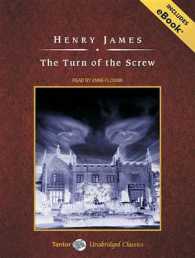- ホーム
- > 洋書
- > 英文書
- > Philosophy
Full Description
Differentiates inquiry from interpretation in order to secure a foundation for truth.
Every man and woman is located in two ways. One is stolidly physical: each human body has a unique address and trajectory. The other comes with beliefs that locate us by answering a salvo of questions: Who, what, and where am I? What are my relations to other people and things? Answers come with either of two emphases. Beliefs critical to practical life and science require that we engage familiar things or find our way in strange cities and streets. Such beliefs supply meaning and security. Ascribing significance to myself or my family, religion, or state, I tell a story that locates me within a world of purpose and value. Neighbors feel and valorize their lives as I do, so our story spreads to dominate a people or an era. One procedure-inquiry-favors reality testing and truth. The other-interpretation-uses meaning to appease vulnerability and glorify believers. Beliefs of these two kinds are sometimes joined, but they are often opposed and mutually hostile. Both philosophy and culture at large confuse these ways of thinking. Styles of Thought distinguishes and clarifies them.
Contents
Introduction
1. Two Styles of Explanation: Interpretation and Inquiry
Interpretation
Inquiry
Different Tasks
Perspective
Contrary Responses: An Example
Mixed Modes
Applications
Values
Morality
Politics
2. Interpretation: Self and Society
Origin and Context
Distortion
Emotion
Assumptions for a Taxonomy
Stories
Socialized Interpretations
Eliding Fact and Value
Magic, Myth, and Metaphor
Faith and Fantasy
Philosophic Rationales
Tolerance
3. Inquiry: Practical Life and Science
Context and Objectives
Meaning
Truth
Animadversions
Engaging Other People and Things
Aims
Ideals
A Choice
4. A Disputed Question
Ontological Alternatives
The Dialectic of Untestable Ideas
Reconciliation
5. Imagination
Construction
Construction Rules
Variation
Discipline
6. Leading Principles
Priority
Precedents
Use
An Inventory of Leading Principles
Values
When Practical Life and Science Disagree
Categorial Form
Afterword
Notes
Index








